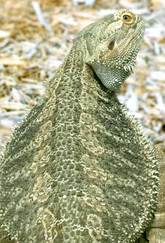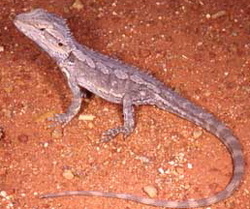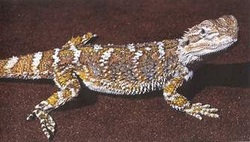Different Types of Bearded Dragons
There are many different species of bearded dragons, and it is very wise to get to know them before you consider buying one.
The ones commonly found in pet stores would be of the last type, the Pogona Vitticeps, the inland bearded dragon. Each names has two parts: the first part of the name is the genus and the second is the species.
The ones commonly found in pet stores would be of the last type, the Pogona Vitticeps, the inland bearded dragon. Each names has two parts: the first part of the name is the genus and the second is the species.
Pogona Barbata

The Eastern Bearded Dragon is a lizard found in wooded parts of eastern Australia, except for the regions of Cape York. It is a large species of variable colour distinguished from its relative, the Central Bearded Dragon (Pogona vitticeps), by its less robust body and the row of spines along the lateral edge of the body, which continues over the forearm. It tends to be more cryptic in its behavior than the Central Bearded Dragon and performs its bearded display more often. It has an adult snout-vent length of about 23 – 25cm.
Pogona Henrylawsoni

Lawson’s bearded dragon is also known by two other common names: Rankin’s dragon and black-soil dragon. It is different from all other members of the genus Pogona in one distinctive way: It is almost clean-shaven! Lawson’s dragon has practically no “beard,” so it cannot properly be called a bearded dragon, although it is similar to beardies in every other respect. Lawson’s bearded dragon is found throughout the black-soil plains of central Queensland and has also been observed on similar terrain in nearby border areas of the Northern Territory. To escape predation in the wild, this lizard has been seen scuttling quickly into and between cracks in the soil. Purebred Lawson’s dragons are well suited for hobbyists who lack the space for larger species. Lawson’s average about 10 inches long, including the tail.
Pogona Microlepidota

These bearded dragons grow to about 11.4 - 14cm; they are a small bearded dragon. They are native only to a tiny region of land in northwest Australia immediately surrounding the Drysdale River basin. This dragon has very strict protective regulations because they are in such a restricted range, so encountering one in the legal pet trade is very unlikely.
Pogona Minima

This is a western bearded dragon and is another small type ranging from 15.2 – 17.8 inches, it is considerably larger than the Drysdale River dragon. They range widely across the western and south-western regions of Australia. This dragon is very similar to dwarf dragon at first glance but they have differences on the back of the neck.
Pogona Minor

This is known as the dwarf bearded dragon and widely ranges from the western Australian coast to deep within the continents interior. Growing to 15.2 – 19.5 cm, they have adapted too many habitats. Despite the lizards infrequent appearance in the wild it is not rare, it’s quite common it’s just simply skilled at hiding!
Pogona Mitchelli

This is one of the smallest dragons it rarely exceeds 12.7 – 15.2 cm. It is found throughout central and western Australia and shares most of its range with the dwarf dragon. It has only been described as a species in the last 30 years. It’s distinguishable by the contiguous row of conical spines along the jaws and head
Pogona Nullarbor

This species is the most strongly patterned bearded dragon, wearing a coat of ivory bands evenly stripped across the body beginning at the base of the neck and extending down to the tail. They are found in a small range in south-central Australia. They are not very common in the U.S. or European pet trade. They display all the benign behaviours and irresistible charms of the popular bearded dragon and would most likely to be a big hit if they were to go into the U.S. or European trade. They are about 12.7 – 15.2 cm in length.
Pogona Vitticeps

Bearded dragons are originally from Australia. They are found mostly in arid, rocky, semi-desert regions, but they are, also, found in arid open woodlands.
Bearded dragons are good climbers, sometimes seen on branches, bushes, and fence posts, but they are mostly terrestrial reptiles.
They are diurnal lizards, spending most of the day basking on rocks and in open areas. During the night and during the hottest parts of the day, they can be found in underground burrows.
Bearded dragons are good climbers, sometimes seen on branches, bushes, and fence posts, but they are mostly terrestrial reptiles.
They are diurnal lizards, spending most of the day basking on rocks and in open areas. During the night and during the hottest parts of the day, they can be found in underground burrows.
